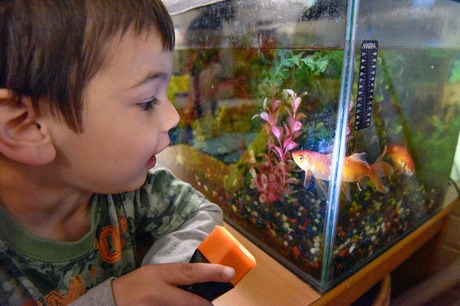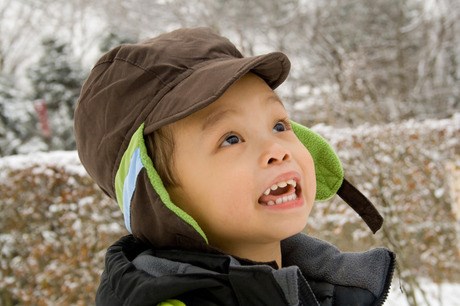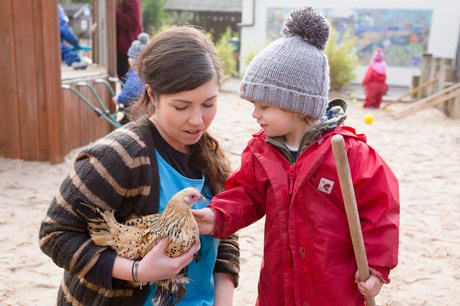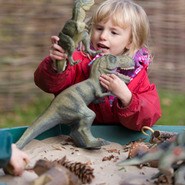EYFS Best Practice - All about…Awe and Wonder
Ruth Thomson
Monday, January 11, 2016
Getting children to experience ‘magical moments’ is a vital learning tool that has far-reaching and very significant impacts, explains early years consultant Kathryn Solly

‘It was through the feeling of wonder that men now and at first began to philosophise’ – Aristotle.
‘Mystery creates wonder and wonder is the basis of Man’s desire to understand’ – Neil Armstrong.
If you work in the early years, you cannot fail to be interested by what fascinates and inspires children. It is those awesome ‘magic moments’ that wow and captivate children, causing their eyes to shine and their tongues to stick out in deep concentration while leading to engagement with a new and wonderful experience.
In a world dominated by technology, it is amazing that we can still be mesmerised by something that is not on a screen. This wondrous experience of beauty can also elicit love, trust and a desire to protect and care for something. This is often associated with feelings of deep connection and pleasure, which in turn has led to much debate.
As we have evolved, these ‘magic moments’ have also helped us to learn quickly and avidly in order to survive.
However, as Rachel Carson writes in The Sense of Wonder, ‘if children are to keep this inborn sense of wonder alive, they need the companionship of at least one adult who can share it, rediscovering with them the joy, excitement and mystery of the world we live in’. So, as practitioners we also need to have a sense of awe and wonder in order to be able to recognise and value it in the child, rather than hurrying children through their day, chasing meaningless outcomes.
While love is about our impulse to be kind, generous, responsible and ‘good’, wonder takes our impulses towards creativity, making connections, nurturing curiosity and learning in the broadest sense. In our complex world, where we are trying to find solutions to potential catastrophes, surely the need to nurture enquiring minds, which can innovate and communicate across human boundaries, is a core value in learning?
WHAT IS AWE AND WONDER?
Wonder is, etymologically, an Old English word that has been joined to the positive qualities of admiration and achievement, as well as having more negative associations with a sense of horror and destruction and, therefore, ethics and moral debate.
The word ‘wonder ‘is often linked to other vocabulary such as awe and mystery, which are about experiences. Young children have spent a short time on the earth and, therefore, much about it is a mystery to them.
Many things adults see are mundane but are of great interest to children. Thus, instead of providing elaborate experiences and outings, which have little impact on the child, practitioners need to respect a child’s interests in the here and now; for example, by observing a spider’s web covered in dew.
THE SEARCH FOR MEANING
Children naturally search for meaning and thus ask numerous questions about the big issues and mysteries in life such as birth, death, trauma, sex and excretion. This search for meaning can be about a unique personal experience or something far more unfathomable.
For children under seven, it is less important to understand concepts in an analytical way than to feel and experience the world as beautiful, whole and amazing. When we use analytical language with young children, we pull them into an adult way of thinking and experiencing, and this can dampen the natural joy and wonder that they feel. Therefore, if we waste our children’s time with such meaningless teaching, or fail to nurture their particular capacity to wonder via ‘magic moments’, we may erode their natural desire to be inquisitive. We may also damage their creativity, critical thinking and collaborative skills as well.
Encountering a real animal is an example of a ‘magic moment’ provocation (above), while toy ones are useful too (right)

AESTHETIC APPRECIATION
As adults, we often hold strong memories of ‘magic moments’ – for example, I can recall pulling lettuces on my father’s allotment… seeing the feathery white rootlets emerge from the fresh-smelling brown earth.
We all need these feelings of awe and wonder if we are to share them purposefully with children. Sharing this means modelling, recognising, responding to, conserving, nourishing, enriching and sustaining ‘magic moments’.
Equally, as an adult, a beach walk, a stroll through autumn leaves or such an amazing sight as a double rainbow can leave us speechless. Simply put, as practitioners we need to recapture our innate sense of awe at what is around us so that we can transfer this gift to children. After all, ‘Life is not measured by the number of breaths we take, but the moments that take our breath away’ (anonymous).
There is also a feeling that makes us aware that we have experienced something special, and this gives us a distinct aesthetic appreciation of the world.
This pure fascination develops early in life, due to a powerfully personal bond (analogous to affection) that develops in aesthetic experience between the subject and object of experience. These terms include attachment, contact, capture, engagement and resonance.
POSSIBLE PROVOCATIONS
I asked the members of the Keeping Early Years Unique group of early years practitioners for their ‘magic moments’. Some of the provocations develop from the child, some from the environment, and some are established by practitioners to build upon children’s interests. The responses are grouped into main features:

Animals
Young animals; for example, chicks hatching, frogs spawning
Snails climbing a window
Seeing how many different kinds of bees were on plants – seven species!
Butterflies emerging from a cocoon
Reading Owl Babies by Martin Waddell and then meeting some real ones
Baby birds in a bird box
Life experiences
Visits from new mothers with babies
Seeing a parent after a long absence
Burying a dead pet
Plants
Digging up potatoes, carrots, etc
Picking and eating strawberries
Dropping an enormous pumpkin, which split open to reveal seeds inside
Seeing the patterns and structure of leaves, feathers, shells, etc
Dried flower heads, such as sunflowers
Natural treasures such as shells, stones, feathers, cones, conkers, bark, petals
Weather, environment, natural phenomena
Glitter, oil and food colour in puddles
Heavy frost like sugar, and frost patterns
Picking a single blade of frosted grass and breathing on it to watch it transform into a water droplet
Standing on a hill with the wind in your hair for the first time
Looking at stars
Splashing through a very long puddle
Seeing a rainbow and noticing it disappear
Making water do things – for example, where does water go in sand?
Feeling ‘small’ standing beneath a huge tree
Watching newts ‘dance’ in the currents made by the hose when refilling the pond
Catching raindrops, hailstones or snowflakes with your tongue
Running through a forest
Sticks in a muddy puddle
Spider webs covered in dew
Tactile materials – for example, wet and dry sand
Autumn leaves and seeds seen through a magnifier
Practitioner-created experiences
Popcorn over a fire bowl
Transient art and loose parts
Poet-in-residence
Farm visit or seeing farm animals for the first time and understanding they are real
Artefacts collected from car boot sales and junk shops
Candles
Bubbles
Holding a mirror to the sky
Being allowed to do things that are normally ‘off limits’
Eating a snack outside in the rain and wind
Binbag kites
Observational drawing and painting of flowers and objects
Expeditions and visits
Watching Tower Bridge open and close/going on the London Eye
Seeing the sea for the first time and running to get in it
When a child in your class sees you as a practitioner out of school!
Going into a place of worship
Visits to the Tate Modern, where children lie on the floor to observe installations
Natural places on both small and large scales – a rock pool, a forest
Resources
LPs and a record player
Overhead projector
Photocopier
POTENTIAL LEARNING
The resultant learning from such varied experiences is clearly extremely wide-ranging and open-ended and will require a teaching environment that truly values child-centred learning via planning through the moment rather than a more rigid outcomes-led approach.
Such excellent practice is evident in the writings and work of Anna Ephgrave and her colleagues. Both The Reception Year in Action and The Nursery Year in Action track the events throughout the year of child-led learning while meeting the requirements of the EYFS.
Links to primary curriculum
The Desirable Learning Outcomes (1996) introduced ‘wonder’ within the area of Personal and Social Development: ‘They [the children] respond to relevant cultural and religious events and show a range of feelings, such as wonder, joy or sorrow, in response to their experiences of the world.’ This is then linked to the National Curriculum in terms of religious education.
The National Curriculum once asked teachers in England to encourage ‘awe and wonder’ in their classrooms. At the time, this may have been seen as unreasonably idealistic, leaving teachers to question whether its authors had actually faced any restless children on a wet afternoon. Yet away from the more burdensome trials of teaching, the experience of wonder remains a potent element.
Links to the Characteristics of Effective Learning
‘Magic moments’ link very strongly with the Characteristics of Effective Learning (CoEL), as they respond innately to the Unique Child and link powerfully within the themes of Positive Relationships, Enabling Environments, and Learning and Development as the child engages with experiences through playing and exploring, active learning and being a creative and critical thinker. I would suggest that ‘magic moments’ actually fulfil most of the CoEL if valued and nurtured by practitioners effectively.
Links across the curriculum
‘Magic moments’ do not occur all the time but act as catalysts within a child’s play that nudge or drive them into really deep involvement. The child is empowered to discover more, to explore, to wallow in learning that is self-directed, as long as practitioners trust them and are not fixated on planning, outcomes and the external expectations of curriculum.
While children have an innate sense of wonder and awe and a natural desire for enquiry, curiosity on its own is not enough. The guidance of a thoughtful and intentional practitioner is essential to enable children to maximise their learning through free explorations, focused explorations and enquiry-based learning opportunities.
It is evident that practitioners can use ‘magic moments’ and natural curiosity to nurture children’s scientific interests and attitudes, providing a clear link to today’s Specific area of learning – Understanding the World. Feasey (2006) referred to these ‘wow’ moments as the focus or motivator for further thinking and enquiry which, in turn, links to the CoEL ‘Creating and thinking critically’.
There are clearly some ‘wow’ experiences that relate to spiritual thinking in children, such as stars and nature. Some may make references to God and mysticism. Others may flow from the awesome impact of nature on our world such as volcanoes, floods, tsunamis and earthquakes.
Aesthetic and mathematical responses come from encounters with flowers, crystals and fossils, leaves and feathers as children start to appreciate nature’s varied forms and patterns.
Children benefit from being given space to ‘be in the moment’
Other ‘wow’ responses come from actual experiences and exploration of natural phenomena such as making a snowball and throwing it, or creating a snow angel. Underpinning them all is pure curiosity – the affective dimension that drives humans to understand reality, moving from ‘wonder at’ to ‘wonder about’ to, finally, ‘wonder whether’ and ‘what would happen if…?’.
Exploring A problem, situation, phenomenon, artefact, model, event, storyObserving What is happening? What changes happened? What is involved? What are the main parts? What do thes parts/structure do?
Showing proof What is the cause and effect of changes? What parts are interacting with other parts? What are th outcomes of these connections? Which patterns keep happening?
Possible explanations Personal explanations supported by ideas that are created, and processes to test them out
Investigating Find out, measure, compare, verify, test
Evaluating Investigations may lead to new or modified explanations and doubts about existing ideas. These tentative explanations need to be discussed and considered
Further investigation Discussions can lead to: re-exploration, seeking further explanation and further investigation
Making connections Explanations are used or applied to make sense of other contexts where similar phenomena are involved
Wonder Wonder about. Wonder at. Wonder whether
]]




